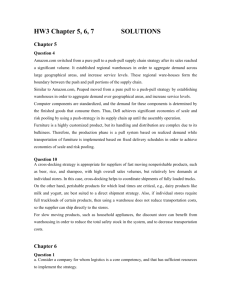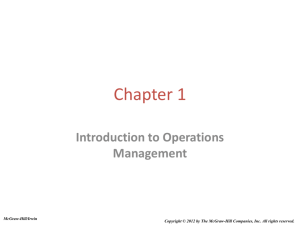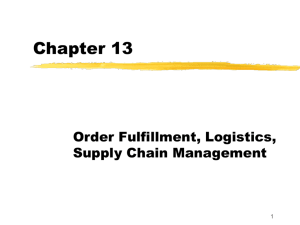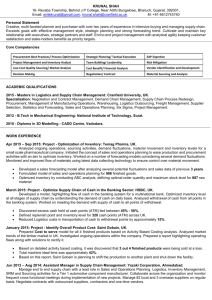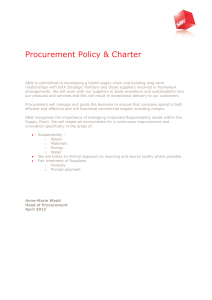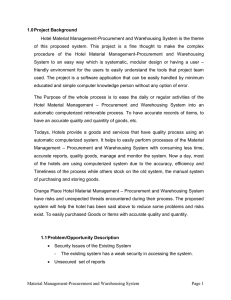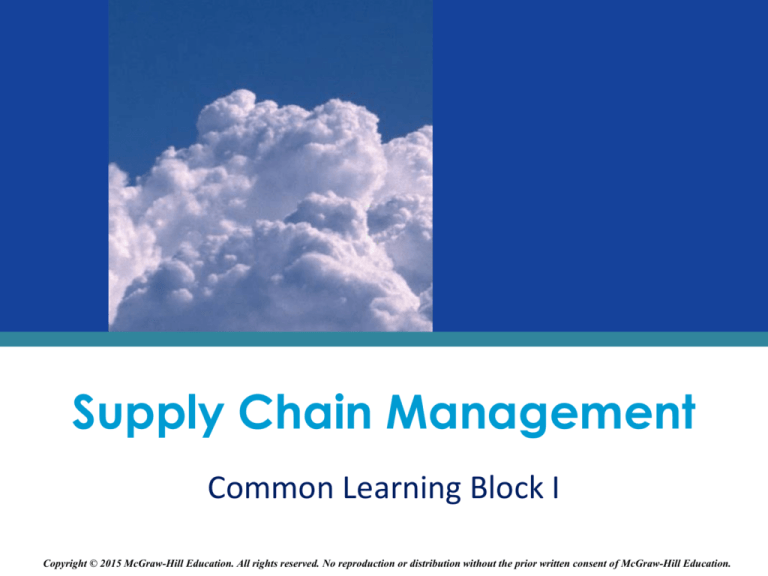
Supply Chain Management
Common Learning Block I
Copyright © 2015 McGraw-Hill Education. All rights reserved. No reproduction or distribution without the prior written consent of McGraw-Hill Education.
Supply Chain Basics
• People / Processes / Technology
• Chain / Network
• Levels of Supply Chain
• First Tier – Factories to main operators
• Second Tier – Suppliers to First Tier
LO1
13-2
Supply Chain
•
•
•
•
•
•
LO1
Customers’ customers
Suppliers’ suppliers
Focal Firms – The Initiator
End Customer
Voice of Customers
Values and Expectations
13-3
Supply Chain Focus
• Products
• Information
• Funds Moving From:
• Suppliers
Distribution
• Retailers
Customers
• Reverse Logistics
LO2
13-4
Supply Chain Management
• Plan / Direct / Control Supply Chains
• CSCMP – Council of Supply Chain
Management Professionals
• It Encompasses The Following:
• Procurement / Conversion / Management
• Links Major Business Functions
• High Performing Business Model
LO3
13-5
Supply Chain Activities
•
•
•
•
•
•
•
•
•
LO4
Sourcing of Raw Materials and Parts
Manufacturing and Assembling
Warehousing and Controlling Inventory
Entering and Managing Orders
Finishing, Customizing and Packaging
Distributing Across All Channels
Delivering to Final Customers
Managing Relationships with Suppliers
Managing Relationships with Customers
13-6
Supply Chain Strategy
• Corporate Strategy Determines Target Mkt
• Compete on Price, Service, Quality,
Innovation, Flexibility or a Combination
• The Business Plan
• Demand & Supply Plan
• Supply Chain (to fill customers orders)
LO5
13-7
Interdepartmental Work
• Functions contribute to goal of securing
lowest transportation Costs
• R&D
• Procurement
• Manufacturing
LO5
13-8
Supply Chain Financials
• Optimizing Supply Chain
• Eliminate Company Vs. Company
• Supply Chain Vs. Supply Chain
• Services – Lower Supply Chain Costs
• Manufacturing – Higher Supply Chain Costs
LO6
13-9
Profit Leverage
• Supply Chain Mgmt Corporate Success
Profit Leverage
• Profit Leverage = Decrease expenses
through Supply Chain Management
• Flows from decreasing expenses and
increasing efficiencies
• Profit Leverage Effect – Providing Industries
with greater options for increasing profits
through expense reduction.
LO7
13-10
Today’s Supply Chain
• Global Era
• U.S. Economic Recession of the 1980’s
• Global Competition (China)
• Characteristics of The Era
• Intense Competition in industries
• New strategies to increase market share
• Rapid increase in technology / shorter product life
cycle e.g. computers, mobile phones, fashion
LO7
13-11
Today’s Supply Chain
• Increased Importance of Supply Chain
• Use of the internet
• Use of International Data Networks
• 2000’s to the present
• Relationships with suppliers
• Cooperation replaced adversarial relationships
• New Strategies
• Supplier Development / Design Involvement / Full
Service Suppliers / Strategic Cost Management
LO7
13-12
Supply Chain Management
Principles
• Procurement – All activities required to
purchase materials, products, and services.
• Operations – The planning and manufacturing
(conversion) of goods.
• Logistics – The movement and storage of
materials, products, and services
• Integration – The communication and visibility
within companies and suppliers; customers
and service providers.
LO8
13-13
Supply Chain
• Estimated to control up to 90% of the cost
associated with delivering a final product or
service
• ERP (Enterprise Resource Planning) – An
integrated, real-time information sharing
module to monitor and control the business
• Can help firms obtain economies of scale
LO8
13-14
Transportation
• Transportation Operations focuses on timely
movement of materials and products within
and between organizations
• Transportation Modes Depend on:
• Costs / Values / Dimensions / Weights / TimeDefinite Delivery / Requirements / Hazardous /
Refrigerated
• Third-party Logistics –
• Forwarders & Brokers
LO8
13-15
Customer Service
• Delivery of Satisfaction – Typically assigned to
logistics or sales
• Focus of Customer Service
• Identifying Customers Needs, Wants, and
Expectations before, during, and after
purchase
• Customer Service Operations Interfaces
with Logistics, Transportation, Operations,
Warehousing & Inventory to control costs
LO9
13-16
Customer Services
• Customer Service Operations is important to:
• The Public Sector (Airports, Ports, & Terminals)
• The Private Sector (Manufacturers, Wholesalers,
Retailers, Carriers, & Third-party logistics providers
• Due to Increased demand & competition, all
industries are involved in Supply Chain e.g.
distribution channels, e-commerce, brick and
mortar stores, & reverse logistics.
• Skills to handle customer complaints and
communicate consistently
13-17
ERP
• In ERP, Customer Service Operation is
supported as follows:
•
•
•
•
Inventory Stock Status
Customer Contact Management
Sales Force Management
Customer Relationship Management (CRM)
13-18
Warehousing
• Warehousing is a function of logistics controls
and involves:
• Receiving / Storing / Retrieving / & Distribution
• Warehousing also provides the following
services:
• Picking / Packing / Final Assembly & Packaging /
Putting Multiple Products Together as kits / &
Refurbishing
13-19
Warehousing
• Warehousing is Supported By:
• WMS (Warehousing Management Systems) within
the ERP system.
• WMS is supported by Integrated Material
Handling Systems such as:
• Equipment to move, put away or retrieve
goods
• Sophisticated flow of information and
communication to optimize efficiency
13-20
Demand Planning
• Demand planning – the process of planning
materials from inbound to manufacturing
• Forecasting – What is needed to have ready
for the customer
• Demand planning focuses on what is
needed in order to meet customer
inventory levels from forecasting
13-21
Inventory Management
• Inventory Management involves
seeing/controlling & managing inventory
levels to maximize efficiency and profitability
• Interacts with:
• Warehousing
• Transportation
• Demand Planning
13-22
Supply Chain Today
• Since the 1980’s • Companies have decreased inventory levels
& carrying costs
• Technology is used to a greater extent today
to meet customers needs with a high level
of service and lower cost
• ERP manages inventory at all levels and is
used to correct errors quickly
13-23
Operations Department
• Operations Department supports lean and
efficient flow of supply management and
procurement
• Global sourcing
• Risk – Climate / Political / Social
• Monitors – Availability / Pricing /Currency
Fluctuations
• Protects Reputation – Socially responsible
practices
13-24
Operations Department
• Procurement – Ensures accurate product
description, collaborates to determine
specifications and quality
• Procurement balances lowest purchase costs
with other impacts on the company including
the time it takes to receive products
• Some suppliers are close to production
facilities others are across continents making
procurement a global function
13-25
Procurement – A Global Function
• Procurement must understand
• International time zones
• Approaches to mitigating interuptions such
as natural disasters, embargoes, strikes and
military action
13-26
EDI
• EDI (Electronic Data Interchange) used in an
effort to decrease costs. EDI is used to:
• Evaluate search engines
• Vendor performance managementp
• Purchase order management
• Bid Management
• Contract Management
13-27


